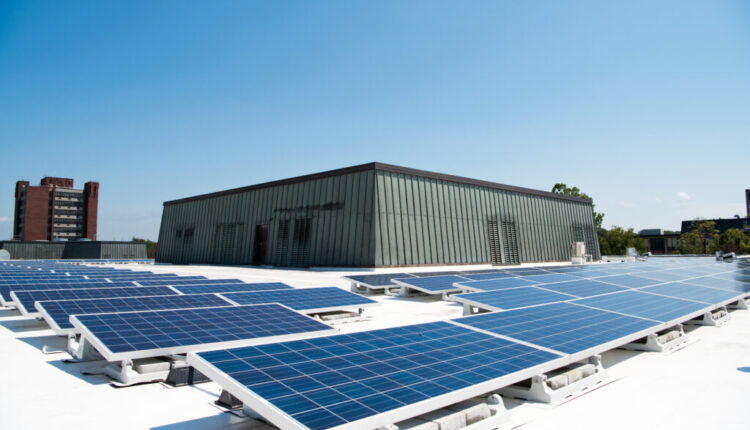Rails vs. Railless vs. Ballasted Mounts: Which Solar Mounting System is Right for You?
When most people think of solar panels, they imagine the sleek, shimmering panels that convert sunlight into electricity. However, what often goes unnoticed is the secret hero among them: the mounting system. This structure ensures that the panels are securely attached to your roof or building and will function efficiently for decades. At Solar Liberty, we know that choosing the right mounting system is just as important as choosing the modules themselves.
There are three main types of mounting systems used today: rail mounting systems, railless mounting systems and ballast systems. Each has different benefits depending on roof type, location and installation goals. Here’s what you need to know to make an informed decision.
Understanding solar mounting systems
A solar mounting system is the physical framework that supports your panels and connects them to your roof or surface. His task is:
- Secure the panels firmly in place even in strong winds or snow loads
- Maintain proper tilt and orientation to ensure optimal sun exposure
- Protect the roof from leaks or structural stress
Each mounting system includes a combination of brackets, clamps, brackets, and sometimes rails designed to balance durability and ease of installation. The right system for your property depends on your roof type, load capacity and aesthetic preferences, as well as environmental factors such as wind speed and snow accumulation.
Rail mounting systems
Rail mounting systems are the traditional and most common method for rooftop solar installations. They use long aluminum or steel rails that run horizontally across the roof and provide a stable base for attaching solar panels.
Installers attach metal brackets or posts directly into the rafters. To prevent water from penetrating, a seal is then installed in these places. The rails are attached to the brackets and the solar modules are clamped onto the rails. This creates a secure and evenly distributed structure that can withstand significant weight and weather conditions. For these reasons, rail mounting systems are best suited for asphalt shingles, tile, and metal roofs.
Advantages:
- Proven reliability: Rail systems have been used for decades, extensively tested and have a long track record of safety.
- Flexible layout options: The panels can be easily arranged around vents, chimneys and roof elements.
- Excellent durability: Rails provide strong support that performs well in high wind and heavy snow environments.
Disadvantages:
- Higher material costs: The rails themselves increase system costs.
- Longer installation time: More components mean more assembly and higher alignment accuracy.
Railless mounting systems
Railless systems completely eliminate the need for long metal rails. Instead, each panel is attached directly to roof-mounted brackets or supports, creating a streamlined and modern design.
Small, flat brackets are attached to the roof structure (often in rafters), and panels are attached directly to these brackets using special clamps. The panels themselves become part of the structural framework, reducing the need for additional hardware. Homeowners who want a minimalist look or reduced material costs will enjoy a trackless mounting system.
Advantages:
- Lightweight construction: Because there are fewer parts, the system increases the overall weight of the roof.
- Faster installation: Fewer components mean faster assembly and lower labor costs.
- Slimmer appearance: The lack of rails provides a cleaner, closer-to-the-roof aesthetic.
- Material efficiency: Less aluminum is used, making it a more sustainable option.
Disadvantages:
- Precision required: The arrangement must be carefully planned as the panels are attached directly to the roof.
- Less adaptable: May be more challenging on uneven or irregularly shaped roofs.
Ballasted assembly systems
Ballasted mounting systems are most commonly used on flat or low-slope roofs, such as commercial buildings or certain modern homes. Rather than being secured through the roof, these systems rely on weight (ballast), typically concrete blocks, to hold the panels in place.
The panels are mounted on trays or racks that rest directly on the roof surface. These frames are weighted with concrete blocks to withstand movement from wind and weather. In some cases, wind deflectors or light roof penetrations are used for additional stability. Ballasted mounting systems are best suited for commercial buildings or homes with flat roofs where minimizing roof penetrations is a priority.
Advantages:
- No roof drilling: Avoids holes or fasteners that could compromise the waterproofing of the roof.
- Easy to adjust or remove: Ideal for rented buildings or roofs that may require maintenance in the future.
- Minimal disruption: Installation is quick and non-invasive.
Disadvantages:
- Heavier overall system: Not all roofs can support the additional weight of ballast materials.
- Limited roof compatibility: Works best on flat, stable roofs.
- Possible wind problems: In areas with high winds, additional anchoring may be required for stability.
Choose the right system for your roof
Choosing the best mounting system isn’t just about the hardware; It’s about finding the right solution for your specific property. Solar Liberty’s team of experts precisely evaluates each installation location, taking into account the following:
- Roof type and construction: Each roof type requires different hardware and techniques.
- Wind and snow loads: Regional weather patterns determine system strength and anchoring needs.
- Local building regulations: Our team ensures full compliance with all structural and electrical regulations.
- Budget and Appearance: Some homeowners value aesthetics, while others focus on cost or ease of maintenance.
Ready for solar energy? Contact Solar Liberty today
Whether your roof requires a track system, a trackless system, or a ballast system, Solar Liberty has the expertise to properly design and install it. Our certified installers use only the highest quality materials and every project is backed by comprehensive warranties for both performance and roof protection.
Contact Solar Liberty today for a free consultation or solar quoteand discover how easy it is to switch to clean, renewable energy with New York’s most trusted solar experts!



Comments are closed.